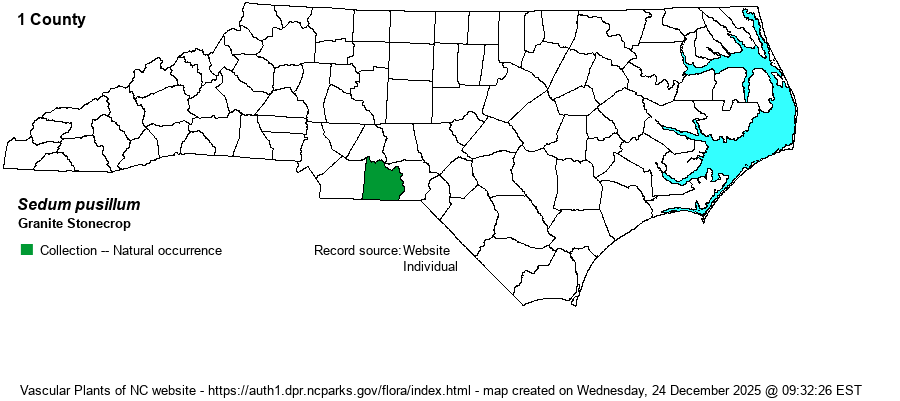| Author | Michaux | |
| Distribution | Known only from a single southeastern Piedmont County (Anson), but it has been recorded at most of the suitable flatrock habitat sites (six) in the county.
This is a Southern Piedmont endemic, ranging from extreme southern NC southwest to eastern AL; known just from four states -- NC, SC, GA, and AL. | |
| Abundance | Very rare in the Piedmont, though technically in Anson County, on the few flatrocks present, it is locally fairly common to common. As far as known, however, none of the sites is in conservation ownership, and thus long-term survival of the species in NC is uncertain. This is a State Endangered species. | |
| Habitat | This is a species restricted to granitic flatrocks, in thin soil around margins of solid rock, usually in damp depressions. It often grows in mats of moss, and it is not as restricted to shallow pools or depressions on the flatrocks as is Diamorpha smallii. |
| Phenology | Blooms in March and April, and fruits from April into May. | |
| Identification | This is a amall species of granitic flatrocks, fairly similar to Diamorpha smallii, though that species has recently been moved to a separate genus. Whereas that species has red stems and leaves, S. pusillum has glaucous (usually pale blue-green or whitish-green but can be pink) stems and leaves, all of which are fleshy. The plants have several branches from the base, usually rather erect, but they grow only to about 4 inches tall. The very numerous and overlapping stem leaves are small and thick, cylindrical in shape and only about 1/5-inch long. At the ends of the branches are the flower clusters, in cymes, with each flower having 4 elliptical petals and a spread of about 1/3-inch across. Some plants can appear pinkish in foliage and be confused with Diamorpha, but that species is usually bright red at all times and has carpals united for 1/3-1/2 of their length, as opposed to Sedum species, which all have carpals separate to the base. Both do occur in Anson County, and thus take care in separating these two in that part of the state. | |
| Taxonomic Comments | None
| |
| Other Common Name(s) | Puck's Orpine | |
| State Rank | S1 | |
| Global Rank | G3 | |
| State Status | E | |
| US Status | | |
| USACE-agcp | FAC link |
| USACE-emp | FAC link |

